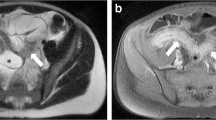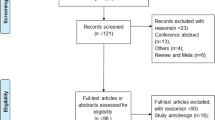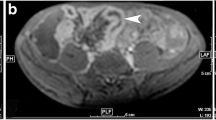Abstract
The purpose of this study was to assess the sensitivity, specificity, and diagnostic accuracy of magnetic resonance imaging (MRI) in pediatric patients with clinical suspicion of inflammatory bowel disease (IBD) by comparing MRI and ultrasound (US) to endoscopy, the gold standard. A median volume of 300 ml of mannitol in a 4.5% watery solution were ingested by 43 children prior to examination. The 53 MRI examinations were compared with 20 endoscopies and 41 US of the terminal ileum. The outcomes were MRI quality; pathologic findings; level of adverse events; and concordance between endoscopy, MRI, and US estimated by kappa statistics. The ileum and terminal ileum were very good or excellently imaged in approximately 80% of cases. Wall thickening and enhancement were most frequent in the terminal ileum. MRI compared with endoscopy had a sensitivity of 81.8% [95% confidence interval (CI)], specificity of 100%, diagnostic accuracy of 90%, and kappa value of 0.80 (95% CI), indicating a good degree of concordance. A similar degree of concordance was achieved between US and endoscopy. In spite of the frequent adverse reactions, such as diarrhea and nausea, half of the patients were prepared to repeat the examination. The results of MRI are concordant with endoscopy and US of the terminal ileum.



Similar content being viewed by others
References
Geboes K, De Hertogh G (2003) Inderterminate colitis. Inflamm Bowel Dis 9:324–331
Laghi A, Borrelli O, Paolantonio P et al (2003) Contrast enhanced magnetic resonance imaging of the terminal ileum in children with Crohn’s disease. Gut 52:393–397
Present DH (2002) Serologic tests are not helpful in managing inflammatory bowel disease. Inflamm Bowel Dis 8:227–229
Maccioni F, Viscido A, Broglia L et al (2000) Evaluation of Crohn’s disease activity with magnetic resonance imaging. Abdom Imaging 25:219–228
Darbari A, Sena L, Argani P, Oliva-Hemker M, Thompson R, Cuffari C (2004) Gadolinium-enhanced magnetic resonance imaging. A useful radiological tool in diagnosing pediatric IBD. Inflamm Bowel Dis 10:67–72
Ha AS, Levine MS, Rubesin SE, Laufer I, Herlinger H (2003) Radiographic examination of the small bowel: survey of practice patterns in the United States. Radiology 231:407–411
Low RN, Francis IR, Politoske D, Bennett M (2000) Crohn’s disease evaluation: comparison of contrast-enhanced MR imaging and single-phase helical CT scanning. J Magn Reson Imaging 11:127–135
Schreyer A, Seiz J, Feuerbach S, Rogler G, Herfarth H (2004) Modern imaging using computer tomography and magnetic resonance imaging for inflammatory bowel disease (IBD) AU1. Inflamm Bowel Dis 10:45–54
Parente F, Greco S, Molteni M, Anderloni A, Maconi G, Porro GB (2004) Modern imaging of Crohn’s disease using bowel ultrasound. Inflamm Bowel Dis 10:452–461
Miao YM, Koh D-M, Amin Z et al (2002) Ultrasound and magnetic resonance imaging assessment of active bowel segments in Crohn’s disease. Clin Radiol 57:913–918
Maccioni F, Viscido A, Marini M, Caprilli R (2002) MRI evaluation of Crohn’s disease of the small and large bowel with the use of negative superparamagnetic oral contrast agents. Abdom Imaging 27:384–393
Rieber A, Nüssle K, Reinshagen M, Brambs H-J, Gabelmann A (2002) MRI of the abdomen with positive oral contrast agents for the diagnosis of inflammatory small bowel disease. Abdom Imaging 27:394–399
Fletcher RH, Fletcher SW, Wagner EH (1996) In: Clinical epidemiology. The essentials, 3rd edn. Williams and Wilkins, Philadelphia, pp 48–49
Altman DG (1996) Practical statistics for medical research, Chapman & Hall, London, pp 404
Gourtsoyiannis N, Papanikolaou N, Grammatikakis J, Maris T (2000) MR imaging of the small bowel with a true-FISP sequence after enteroclysis with water solution. Invest Radiol 35:707–711
Rieber A, Aschoff A, Nüssle K et al (2000) MRI in the diagnosis of small bowel disease: use of positive and negative oral contrast media in combination with enteroclysis. Eur Radiol 1377–1382
Masselli G, Brizi GM, Parrella A, Minordi LM, Vecchioli A, Marano P (2004) Crohn disease: magnetic resonance enteroclysis. Abdom Imaging 29:326–334
Schunk K, Kern A, Oberholzer K et al (2000) Hydro-MRI in Crohn’s disease: appraisal of disease activity. Invest Radiol 35:431–437
Ajaj W, Goehde SC, Schneemann H, Ruehm SG, Debatin JF, Lauenstein TC (2004) Oral contrast agents for small bowel MRI: comparison of different additives to optimize bowel distension. Eur Radiol 14:458–464
Narin B, Ajaj W, Gohde S et al (2004) Combined small and large bowel MR imaging in patients with Crohn’s disease: a feasibility study. Eur Radiol 14:1535–1542
Borthne AS, Dormagen JB, Gjesdal KI, Storaas T, Lygren I, Geitung JT (2003) Bowel MR imaging with oral Gastrografin: an experimental study with healthy volunteers. Eur Radiol 13:100–106
Borthne AS, Abdelnoor M, Hellund JC et al (2005) MR imaging of the small bowel with increasing concentrations of an oral osmotic agent. Eur Radiol 15:666–671
Schunk K (2002) Small bowel magnetic resonance imaging for inflammatory bowel disease. Top Magn Reson Imaging 13:409–425
Bigard M, Gaucher P, Lasalle C (1979) Fatal colonic explosion during colonoscopic polypectomy. Gastroenterology 77:1307–1310
Author information
Authors and Affiliations
Corresponding author
Additional information
An erratum to this article can be found at http://dx.doi.org/10.1007/s00330-006-0322-2.
Rights and permissions
About this article
Cite this article
Borthne, A.S., Abdelnoor, M., Rugtveit, J. et al. Bowel magnetic resonance imaging of pediatric patients with oral mannitol. Eur Radiol 16, 207–214 (2006). https://doi.org/10.1007/s00330-005-2793-y
Received:
Revised:
Accepted:
Published:
Issue Date:
DOI: https://doi.org/10.1007/s00330-005-2793-y




